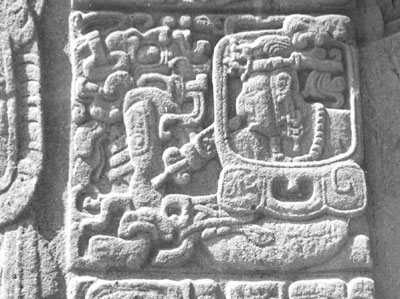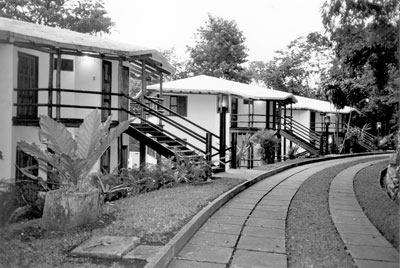A tale of three Mayan cities
by Julie Skurdenis
My most recent trip to Guatemala, in January 2006, began with the popular television reality program “Survivor.” The show is now in its 12th season, but it was the 11th season, which aired in fall 2005, that set me on the road to Guatemala again. In that season, the series was set in the Mayan archaeological site of Yaxha in the remote Petén jungle of northeastern Guatemala. Here among Mayan pyramids, some of which date back more than 1,500 years, contestants competed against each other for a one-million-dollar prize.
While they focused on outmaneuvering each other, I focused on what I could see of the archaeological site on television over many successive weeks. Although I’ve been to Guatemala twice before (1988 and 1993), seeing Yaxha on TV made me eager to return.
Yaxha is an intriguing-enough site, especially since much of it still remains buried under green mounds, but Guatemala is also home to two of the greatest Mayan archaeological sites — Tikal and Quiriguá — both of which are UNESCO World Heritage Sites. A third Mayan site, Copan, lies just across the border in neighboring Honduras. It too is on the UNESCO World Heritage Sites list.
Maya timeline
Massive glaciers covering the Northern Hemisphere roughly between 20,000 and 7,000 B.C. created a land bridge between Asia and Alaska. The people who became the Maya and who eventually settled in what is now Mexico and Central America may have been among the first to cross this land bridge which is now the Bering Strait.
Mayan history in North America can be divided roughly into the following periods: Archaic (20,000 B.C.-2000 B.C.), Preclassic (2000 B.C.-A.D. 250), Classic (A.D. 250 -900) and Postclassic (A.D. 900 to the coming of the Spanish conquistadores in the 1520s). It was during the Classic period — corresponding roughly to Europe’s “Dark Ages” — that the Maya reached the apogee of their civilization, evident in the cities they constructed full of temple complexes.
Tikal
Among the greatest of the Mayan cities was Tikal. It is certainly the preeminent Mayan archaeological site left to us today. Located 18 miles northwest of Yaxha, Tikal was first settled about 700 B.C., grew rapidly from about A.D. 250 to 700, when it reached its high point with a population of perhaps 100,000 under a ruler called Ah Cacau (Lord Chocolate), and then as rapidly declined after A.D. 900 due probably to a depletion of wood, land and water resources as well as war and famine.
But during the period of growth, the Classic period, Tikal’s kings built and built and built. In just the central portion of this immense archaeological site it is estimated that there are over 4,000 structures.
The “must sees” for even the most hurried visitor include the Great Plaza, the heart of Tikal, bordered by the twin temples I and II, called the Temple of the Jaguar and the Temple of the Masks, and by the North Acropolis, where a dozen temples sit atop a huge platform with altars and stelae (stone pillars) lined up in front, and the Central Acropolis, a vast palace complex of rooms, courtyards and small temples.
Beyond the Great Plaza is Mundo Perdido (Lost World), three dozen structures surrounding a 110-foot-high central pyramid with four earlier pyramids buried within. Still farther along lies Temple IV, at 210 feet the tallest at Tikal.
My husband, Paul, and I did not find it “easy going” at Tikal. It is a 30-minute rocky walk just from the entrance of the site to the Great Plaza. You can easily walk four or five miles on even a short visit. If you’re trying to see everything in one day, allow at least five hours, wear shoes with a good grip, carry water and pace yourself.
We went to Tikal twice on this trip: once with a guide who more or less ran us through the important sites, and once two days later on our own. We enjoyed it much more seeing Tikal at our own pace, although having a guide is useful for first timers. There is an excellent, very thorough booklet, “Tikal” by William Coe, available in hotel shops in Guatemala City or at the site.
Quiriguá
Quiriguá is located in southeastern Guatemala, about 120 miles from Guatemala City. It flourished during the Classic period mostly under the domination of Copán, located 30 miles away (now in Honduras). At Quiriguá two kings, Cauac Sky (A.D. 725-784) and Sky Xul (784- 800), erected stelae that are among the tallest in the Mayan world.
Surrounded by banana groves, the stelae are scattered along what was once the Great Plaza. Some of these stelae tower 33 feet, most protected by thatched coverings that make them difficult to photograph. The glyphs on these stelae are vividly carved, while many of the figures, presumably of Cauac Sky or Sky Xul, resemble Egyptian pharaohs (with false beards and staffs of office) more than Mayan kings.
At the end of the Great Plaza is the Acropolis with unique stone zoomorphs portraying frogs, turtles, jaguars and serpents lined up.
Quiriguá is an easy site to visit. It’s level, except for the Acropolis. Allow at least an hour and a half for a leisurely visit.
Copán
The third of Guatemala’s UNESCO World Heritage Sites, Copán, is located in Honduras only eight miles from the Guatemalan border. If you’re visiting Quiriguá, it’s only 30 miles away “as the crow flies.” Otherwise, it’s a long 110 miles by road. Still, Copán shouldn’t be missed.
One royal family consisting of 17 kings ruled during much of the Classic period, from A.D. 426 to about 790, the greatest two of whom ruled for a total of 110 years: Smoke Jaguar for 67 years (A.D. 628-695) and 18 Rabbit for 43 years (695-738) until he was beheaded by Quiriguá’s king, Cauac Sky.
The “must sees” at Copán include the Great Plaza, dotted with huge stelae (seven of which depict King 18 Rabbit); the second-largest ball court in Central America, and the magnificent Hieroglyphic Stairway, whose steps are carved with thousands of glyphs detailing the history of the royal house of Copán up to the mid-eighth century A.D. At the base of this stairway is a stela showing its builder, King Smoke Sky, wearing a feathered cloak.
There’s also the Acropolis with East and West Plazas. In the West Plaza is Altar Q, depicting 16 of the 17 kings of Copan. In the East Plaza are two tunnels leading to temples buried beneath existing temples.
Copán is also fairly easy to visit, since it is almost entirely level except for the Acropolis. Allow at least 2_ hours for a leisurely visit.
In Guatemala City, two museums not to miss are the modern Museo Popol Vuh on the campus of the Universidad Francisco Marroquin and the more traditional Museo Nacional de Arqueologia near the Parque Aurora.
Other highlights
The above-mentioned sites were the archaeological highlights of our Guatemalan trip. A sampling of nonarchaeological highlights included strolling the cobblestone streets of Antigua, a lovely city founded in 1543 in the shadow of three volcanoes; bargaining for colorful weavings and folk craft at the twice-weekly market in Chichicastenango; visiting villages scattered along the steep slopes of Lake Atitlán; reveling in the color and intense activity of the nontouristy vegetable market at Almolonga (I’ve never seen such huge cabbages, carrots and onions); marveling at the facade of the church in the town of San Andrés Xecul, exuberant with brightly colored angels, saints and jungle animals, and floating past tall vertical cliffs on the Rio Dulce.
Special hotels
An unexpected bonus on this trip was the number of beautiful and/or unique hotels. We stayed in 10 hotels over 16 nights and, of these, seven were special. To mention a few, the Villa Maya in Santa Elena near Tikal, with designer interiors and small terraces overlooking a lake with resident crocodiles; the Catamaran on the Rio Dulce, with rustic cabins on stilts hovering over the water; the Marina Copán near the Copán ruins, with private patios and terraces set among ponds and luxuriant foliage, and the Casa Santo Domingo in Antigua, overflowing with charm and antiques, whose rooms come with patios or balconies and fireplaces.
The Santo Domingo is one of the most beautiful hotels we have ever stayed in, and we’ve stayed in hundreds over 38 years of traveling.
If you go. . .
Paul and I traveled with Mayatour (3412 Leigh Rd., Pompano Beach, FL 33062; 800/392-6292 or 954/942-6262, fax 954/783-7414 or visit www.mayatour.com), a company that specializes in tours of the Mayan world — Guatemala, Mexico, Belize, Honduras and Nicaragua.
Our 13-night tour, “Guatemala: from the Living Maya of the Highlands to the Ancient Cities of the Petén,” cost us $1,880 per person, including hotels, breakfasts, tours, admission charges and transportation. This tour is offered weekly. We added three nights to the tour. Flights to Guatemala City from the U.S. were not included.



